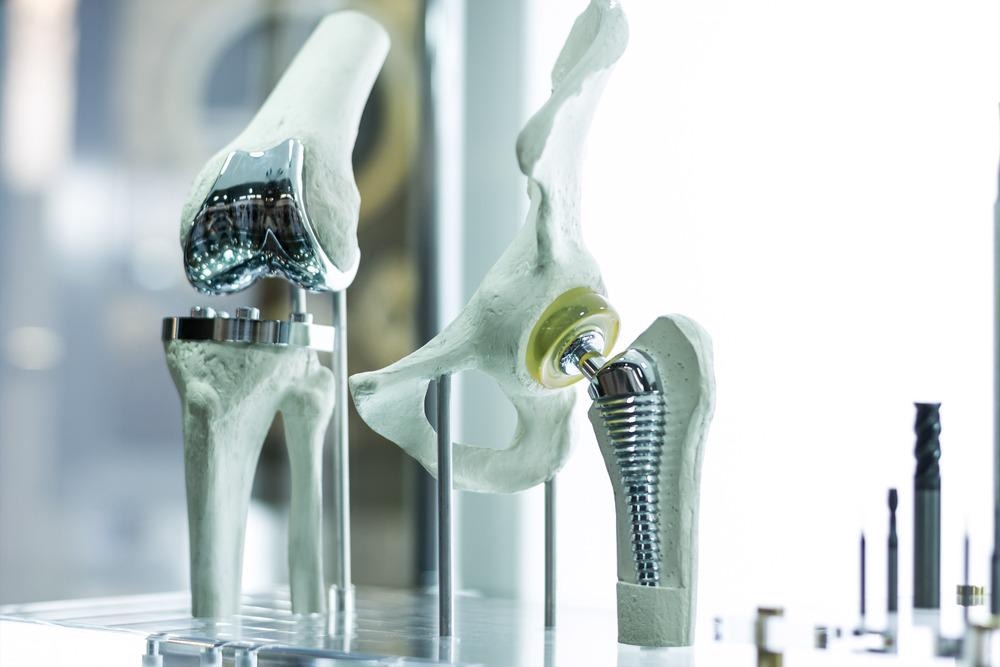 By Surbhi JainReviewed by Susha Cheriyedath, M.Sc.Mar 24 2022
By Surbhi JainReviewed by Susha Cheriyedath, M.Sc.Mar 24 2022In a review recently published in the open-access journal Materials, researchers discussed the recent advances in copper-doped titanium implants.

Study: Recent Advances in Copper-Doped Titanium Implants. Image Credit: Monstar Studio/Shutterstock.com
Background
Because of their superior mechanical qualities, excellent corrosion resistance, and ideal biocompatibility, titanium (Ti) and its alloys have been widely employed in human implants. However, due to Ti and its alloys' low intrinsic osteogenic potential, bone repair and regeneration are hampered, and implant-related infection or inflammation remains the predominant cause of implant failure.
Infections caused by bacteria or inflammatory illnesses pose a serious hazard to human health. As a result, limiting bacterial invasion is critical for implantation success, and increasing the antimicrobial characteristics of implant materials is a top priority.
Cu has been widely employed in biomedical materials to boost their antibacterial ability. Many studies have demonstrated that Cu-doped Ti implants are resistant to bacterial adhesion and biofilm formation.
About the Study
In this study, the authors examined current developments in the design and preparation of Ti alloy and Cu-doped Ti implants, with an emphasis on a variety of techniques such as magnetron sputtering, plasma immersion implantation, micro-arc oxidation (MAO), galvanic deposition, and sol-gel synthesis. The mechanical and antibacterial properties of Cu-doped Ti implants, as well as their biocompatibility and corrosion resistance, were evaluated, and their limitations and prospects were also discussed.
The team presented a timely review of current advancements in Cu-doped Ti implants, wherein their preparation technique and bone-enabling characteristics were investigated. The osseointegration process and bacterial infection of medical implants were discussed. Recent breakthroughs in the use of Cu dopants to modify the surface of Ti-based medical implants were summarized.
The authors also illustrated the effect of Cu dopants on the characteristics of Cu-doped Ti implants.
Observations
Several studies reported that the modification of titanium and titanium-based implants for the prevention of prosthetic infections was a difficult task. Bacterial colonization could be prevented by using Cu as an antibacterial agent directly grafted onto the implant surface.
Titanium alloy was utilized in many clinical applications due to its excellent corrosion resistance and strength. The use of ion implantation technology significantly improved the surface wear resistance of the material. MAO technology had the advantage of being easy and quick to process; nevertheless, because of its high energy consumption, it had significant commercialization costs.
More from AZoM: What Do We Know About MXene Epoxy Resin?
The coating thickness could be controlled by modifying the process parameters, and co-sputtering of multiple metals could be achieved. It was observed in many studies that although sol-gel technologies were simple to use at the molecular level, they were rather time-consuming and costly. The bactericidal rate of Staphylococcus aureus was found to be 92% when Cu2+ had a concentration of 5 x 10-5 M, but the bactericidal rate of E. coli was 93% when Cu2+ had a concentration value of 5 x 10-6 M. Antibacterial activity had a substantially lower effective concentration than cytotoxicity. On human gingival fibroblasts, the median lethal dose of Cu ions was found to be 21.86 mg L-1. MC3T3 cells were cytotoxic when the concentration of Cu ion was more than 9 mg/L.
Many studies demonstrated that even when the concentration of Cu ions emitted was very low, Cu-doped Ti-based implants had antibacterial properties. Cu ions were released from the antibacterial Ti6Al4V-5Cu alloy at a rate of 2.498 ± 0.755 g/L after 20 days in a 0.9% NaCl solution. Cu-containing particles had the ability to prevent bacterial adherence and biofilm formation. It was demonstrated that Ti-Cu alloys could promote osteogenic differentiation in MG-63 cells by enhancing the expression of osteogenic-related genes like Collagen I, ALP, OCN, and OPN.
Conclusions
In conclusion, this review elucidated that because of their strong antibacterial and bone-enabling qualities, as well as their good corrosion resistance and mechanical properties, Cu-doped Ti-based implants have a lot of potential for future uses.
It was observed that no Ti-based implants having Cu components are currently accessible on the medical device market. Also, for dental and orthopedic implants, the issue of prosthesis infection was found to be a major concern. The authors proposed to combine various antibacterial elements with contributing bone components such as Cu2+, Ag+, Sr2+, and Zn2+. They emphasized that the development of new metal surfaces that could improve and increase tissue integration while also providing long-lasting antibacterial benefits should be a focus of future biomaterials research.
They also observed that the impact of loading Cu on the implant surface in various ways on cellular/tissue response and antimicrobial activity has yet to be determined.
Disclaimer: The views expressed here are those of the author expressed in their private capacity and do not necessarily represent the views of AZoM.com Limited T/A AZoNetwork the owner and operator of this website. This disclaimer forms part of the Terms and conditions of use of this website.
Source:
Wu, Y., Zhou, H., Zeng, Y., et al. Recent Advances in Copper-Doped Titanium Implants. Materials 15(7) 2342 (2022). https://www.mdpi.com/1996-1944/15/7/2342